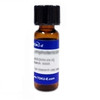Gliotoxin is a potent epithiodioxopiperazine mycotoxin produced by species of Gliocladium, Aspergillus and Penicillium. Gliotoxin inhibits a number of thiol-requiring enzymes and displays antioxidant and immunomodulatory activity.
Gliotoxin is soluble in ethanol, methanol, DMF or DMSO. Poor water solubility.
Gliotoxin is soluble in ethanol, methanol, DMF or DMSO. Poor water solubility.
| Mechanism of Action | At the cellular level gliotoxin inhibits a broad range of unrelated mechanisms, including inhibition of chymotrypsin-like activity of the 20S proteasome and Ca2+ release from mitochondria, activation of transcription factor NF-κB in response to a variety of stimuli in T and B cells, anti-inflammatory activity, and inhibition of farnesyltransferase and geranylgeranyltransferase. The mode of action appears to be via covalent interaction with proteins through mixed disulphide formation. |
| Molecular Formula | C13H14N2O4S2 |
| References | Gliotoxin, the antibiotic principle of Gliocladium fimbriatum. I. Production, physical and biological properties. Johnson D. et al. JACS 1943, 65, 2005. The epipolythiodioxopiperazine (ETP) class of fungal toxins: distribution, mode of action, functions and biosynthesis. Gardiner D. M. et al. Microbiology 2005, 151, 1021. Gliotoxin is a dual inhibitor of farnesyltransferase and geranylgeranyltransferase I with antitumor activity against breast cancer in vivo. Vigushin D. M. et al. Med. Oncol. 2004, 21, 21. The secondary fungal metabolite gliotoxin targets proteolytic activities of the proteasome. Kroll M, et al. Chem. Biol. 1999, 6, 689. The immunosuppressive fungal metabolite gliotoxin specifically inhibits transcription factor NF-kappaB. Pahl, H. L. et al. J.Exp. Med. 1996, 183, 1829. Gliotoxin stimulates Ca2+ release from intact rat liver mitochondria. Schweizer M. & Richter C. Biochemistry 1994, 33, 13401. |



